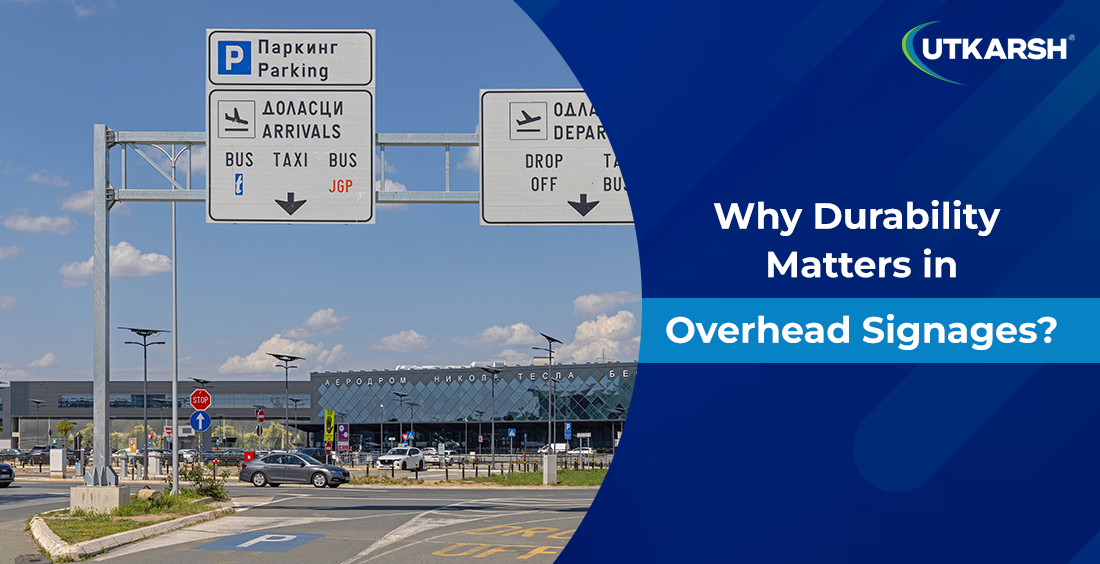Why Durability Matters in Overhead Signages ?

Overhead signages are key to keeping traffic flowing smoothly and providing important information to drivers and pedestrians. With India’s expanding road network, the need for reliable and long-lasting signages is growing. These signages do more than mark routes—they help improve traffic flow and enhance the driving experience. One often overlooked aspect is the durability of these signages. Choosing durable signages is essential to ensure they withstand harsh conditions and continue to function effectively. Let’s explore why long-lasting overhead signages are so important for efficient road systems.
Withstanding harsh weather conditions
India experiences a diverse range of weather conditions, from blistering summer heat to torrential monsoons and even harsh winters in some regions. Overhead signages need to be built to withstand these extreme weather changes. Durability here is not just about withstanding physical wear and tear—it’s also about ensuring the signages remain visible, legible, and functional throughout these challenges.
Consider a stretch of highway that faces heavy monsoon rains every year. If the signages are not durable enough, they may rust, fade, or become structurally weak, leading to frequent replacements and higher maintenance costs. On the other hand, durable overhead signages made from high-quality materials will continue to function properly even during the harshest conditions.
The importance of durable masts for overhead signages
It’s not just the signages themselves that need to be durable—the structures that support these signages are equally important. They bear the weight of the signages and must endure constant exposure to environmental conditions such as high winds, heavy rains, and intense sunlight. If the masts are not sturdy enough, they risk collapsing, which can result in disruptions and added costs.
Durable masts made from galvanised steel are an excellent choice for overhead signages. Galvanisation is a process where steel is coated with a protective layer of zinc - the process significantly enhances steel’s resistance to rust and decay. This is particularly important in regions that face high humidity or pollution, such as coastal areas or industrial zones. Galvanised steel masts can withstand these harsh conditions, ensuring that the signage remains securely mounted and intact for extended periods.
Wind load certification and stability
Another critical factor to consider is wind load certification for the masts. Many parts of India, particularly along the coastline, are prone to high-speed winds and storms. Overhead signage structures must be able to withstand these forces without collapsing or becoming damaged. Wind load-certified products are tested to meet quality standards, ensuring they can remain stable under challenging weather conditions.
For example, in cyclone-prone regions, overhead signage structures must be robust enough to withstand the force of high winds. Installing wind load-certified masts and signages ensures that they can endure such extreme conditions without failure.
Long-term benefits of investing in durability
Investing in durable overhead signages and masts may have a higher upfront cost, but the long-term benefits far outweigh this initial investment. Frequent replacements and maintenance of inferior signages are not only costly but also create inconvenience. Every time a damaged signage or mast needs to be replaced, it can lead to roadblocks and increased project timelines.
Looking for information on a trustworthy signage pole manufacturer in India?
Explore our signage structures. Our production range includes masts for fixed retro-reflective signage on angled structures, as well as motorised masts for raising and lowering signages with integrated light fittings. We also offer the option to supply structures specifically designed for securing signages, providing a complete solution for various road and highway requirements. Our mast designs cater to a range of needs, with heights available from 10 metres to 60 metres. This flexibility ensures that our products can meet the demands of different road conditions and environments, providing reliable support for overhead signage across a wide range of applications.